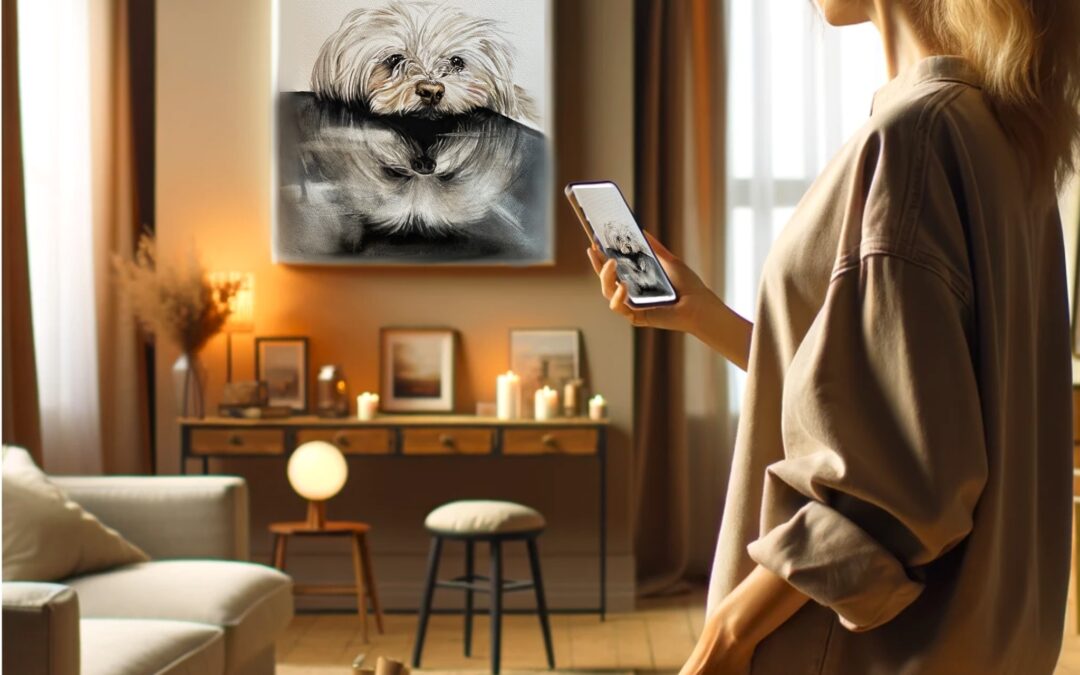Viewing Your Pet Portrait with Perspective
Embracing the Big Picture
In the digital age, the way we view art, especially personalised pieces like pet portraits, has transformed drastically. Often, we’re given a digital glimpse of our commissioned artwork through our phone screens, tempting us to zoom in and scrutinise every detail. However, true appreciation of art, particularly in forms like watercolour pet portraits or whimsical sketches, requires a step back – both literally and figuratively.
Why Distance Matters
Historically, artists have always viewed their work from a distance. This practice allows for a comprehensive understanding of the piece, ensuring balance, harmony, and the right interplay of colors and shapes. Art critic John Berger, in his seminal work ‘Ways of Seeing’, emphasises the importance of viewing art from the artist’s perspective – often from a few steps back. This is crucial in understanding the artwork as a cohesive whole, rather than a sum of its parts.
The Digital Dilemma: Color Fidelity and Screen Limitations
When viewing digital images of art on our phones, we face the challenge of colour distortion. The luminance and colour settings of our screens can significantly alter the appearance of the artwork. Art consultant Sarah Seamark explains that the ambient light in which an artist creates a piece plays a significant role in its true colour, a nuance often lost in digital representations.
Steps to Viewing Digital Art Images
- Find the Right Environment: View the digital image in a well-lit room, ideally with natural light, to get closer to the true colours.
- Maintain a Distance: Hold your phone or device at arm’s length. Resist the urge to zoom in, allowing your eyes to take in the entire composition.
- Seek Consistency: Compare the digital image across different devices, if possible, to get a more rounded idea of the colour scheme.
Engaging with the Artist
When reviewing digital proofs of your pet portrait:
- Ask About Lighting Conditions: Inquire about the lighting in which the artist worked. This can help you adjust your expectations when viewing the digital image.
- Request Overall Shots: Ask the artist for images that show the artwork in its entirety, including the surroundings, to better understand scale and colour.
- Discuss Subtle Changes: If the artist needs to makes adjustments, give a detailed explanation of what needs to be altered, maybe include more images to help them. Check this blog post for more tips on changes to your commissions.

Key Aspects to Look For
- Overall Balance: Look for the harmony between elements rather than focusing on minute details.
- Colour Interplay: Observe how colours interact with each other, understanding that subtle variances might occur in person.
- Emotional Resonance: Step back and consider how the piece makes you feel. Often, the emotional connection is more evident from a distance.
Conclusion
Viewing art, especially personalised portraits of your beloved pets, is an exercise in perspective – both in the physical and metaphorical sense. By embracing these techniques, we can appreciate the artwork as intended by the artist, bridging the gap between digital previews and the tangible beauty of the final piece.
Sam x
sign up
Subscribe

The Creative Block: Inside the Mind of an Artist When Inspiration Fades
Inside the Mind of an Artist When Inspiration FadesEvery artist, no matter how inspired, faces moments when their mind suddenly shuts...

The Emotional Cost of Art: A Collector’s Insight into the Artist’s Journey
A Collector’s Insight into the Artist’s JourneyI had just finished sending a long text to my mum, pouring out my frustrations about this...

Discovering My Artistic Style: A Six-Month Journey
A Six-Month Journey Embarking on a creative journey often requires more than just a shift in technique or palette. For me, the last six...

Embracing the Struggle
My Journey from Teaching to Learning. Embarking on an Artistic Growth Journey can transform challenges into stepping stones for...
